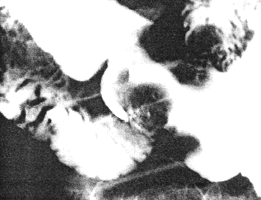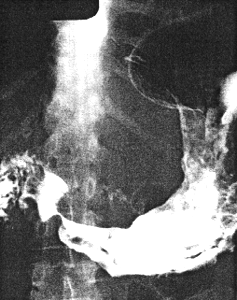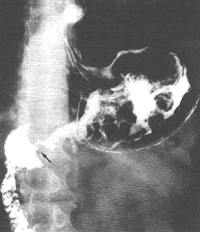


Go to chapter: 1 | 2 | 3 | 4 | 5 | 6 | 7 | 8 | 9 | 10 | 11 | 12 | 13 | 14 | 15 | 16 | 17 | 18 | 19 | 20 | 21 | 22 | 23 | 24 | 25 | 26 | 27 | 28 | 29 | 30 | 31 | 32 | 33 | 34 | 35 | 36 | 37 | 38 | 39
Chapter 33 (page 165)




Go to chapter: 1 | 2 | 3 | 4 | 5 | 6 | 7 | 8 | 9 | 10 | 11 | 12 | 13 | 14 | 15 | 16 | 17 | 18 | 19 | 20 | 21 | 22 | 23 | 24 | 25 | 26 | 27 | 28 | 29 | 30 | 31 | 32 | 33 | 34 | 35 | 36 | 37 | 38 | 39
Chapter 33 (page 165)
 |
Fig. 33.1.Case A.S. Lobulated filling defect in pyloric sphincteric cylinder. Mucosal folds and cyclical activity absent. Pyloric aperture patent. Base of duodenal bulb normal. |
Case 33.2 J.B., 65 year old female, presented with a large epigastric mass and left
supraclavicular Virchow Trosier lymphadenopathy. Radiology showed a constant,
irregular narrowing of the distal 8.0 cm of the stomach, with an intraluminal filling defect
extending to the pyloric ring. There was narrowing of the aperture and delayed emptying
of barium suspension, indicating partial obstruction of the gastric outlet (Fig. 33.2). Food
residues were present in the proximal stomach. Mucosal folds were absent in the affected
region. There was total absence of cyclical activity of the pyloric sphincteric cylinder.
The lesser curvature side of the base of the duodenal bulb showed a smooth, concave
identation, apparently due to external pressure; in other respects the bulb appeared
normal.
At laparotomy a large carcinoma of the distal part of the stomach, causing partial
obstruction, was found. Aborally the tumor boundary was at the pyloric ring; no
duodenal infiltration was noted. There was widespread infiltration in the region of the
pancreas, in the gastrohepatic and gastrocolic omenta, as well as lymph gland extension.
The tumor proved to be unresectable and a palliative gastro-enterostomy was done.
Histology of involved lymph nodes showed a papillary adenocarcinoma.
 |
Fig. 33.2.Case J.B. Irregular narrowing distal stomach with intraluminal filling defect. Mucosal folds and cyclical activity of pyloric sphincteric cylinder absent. Pyloric aperture narrowed. Food residues proximal stomach. Concave indentation base of bulb. |
Case 33.3 C.J., 57 year old male, presented with loss of appetite and weight of 3
months' duration. Radiology showed a constant, irregular, constricting filling defect of
the distal 5.0 cm of the stomach, with absent mucosal folds. Aborally, it extended as far
as the pyloric ring (Fig. 33.3). There was a total absence of cyclical contraction and
relaxation of the sphincteric cylinder; emptying of fluid barium was not delayed
significantly. The base of the duodenal bulb showed shallow, concave indentations on
either side of the pyloric aperture, the appearance being suggestive of external
impressions. The duodenal "tail" appeared normal (Chap. 13).
Gastroscopy showed a friable, haemorrhagic, polypoid tumor in the corpus and "antrum"
of the stomach; the pylorus and duodenum appeared normal. Endoscopic biopsy
revealed a moderate to poorly differentiated adenocarcinoma. At laparotomy the aboral
border of the tumor was at the pylorus; macroscopically the duodenum was not involved.
On the oral side it extended to just below the gastro-oesophageal junction. The tumor
was considered to be unresectable and the abdomen was closed.
 |
Fig. 33.3.Case C.J. Irregular, constricting filling defect distal stomach. Mucosal folds and cyclical activity of sphincteric cylinder absent. Duondenal tail (arrow) normal. Concave indentations base of bulb on either side of pyloric aperture. |
Previous Page | Table of Contents | Next Page
© Copyright PLiG 1998